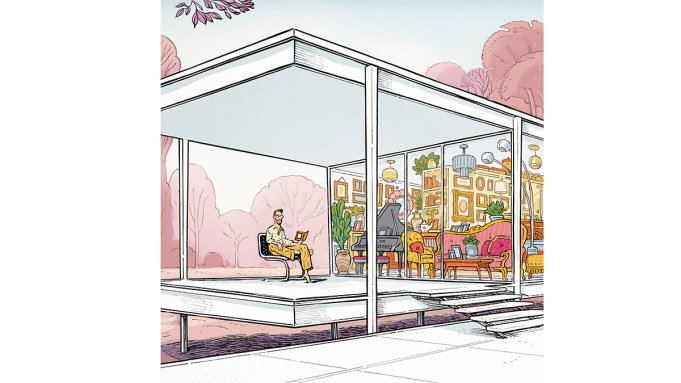
Illustration: Lars Lietal
We all know the saying: “Less is more.” Over the past century, this maxim has become a battle cry for architects and designers, defining a modernist aesthetic that champions minimalism and sophistication over the busy and decorative as the path to a better life. did. But hasn't our understanding of minimalism itself become a little too reductive? And does it also fit into our collective ethos here in 2024?
This pithy phrase was popularized by 20th century German-American architect Ludwig Mies van der Rohe, but it doesn't apply to how many of his clients actually lived in his buildings. . An icon of his modernist glass box, Farnsworth's photographs of his House show spaces arranged exactly as Mies envisioned them, with streamlined furniture and pared-down interiors.
In fact, this house had a completely different form of residence, depending on the doctor and poet who commissioned it and gave it its name. Dr. Edith Farnsworth, a music and travel enthusiast, has enlivened her weekend home with eclectic furniture and memorabilia. It wasn't minimal.
What this example shows is that maximalism has always existed alongside minimalism. History likes to progress in a linear fashion from one clear idea to another, but in reality, culture is much more complex and multifaceted. The past century has been defined in many circles as the era of minimalism, peaking in recent years with the rise of decluttering advocates like Marie Kondo and Fumio Sasaki, but beneath the surface, there's always been a feeling of “More is more.” “more” was flowing out. It might just be boiling over today.
In 2019, Swedish sociologist Ylva Ugra analyzed the central idea behind the growth of minimalism in modern Western culture. She noticed that the minimalist lifestyle, which celebrates downsizing, has become a trend in countries like Japan, the United States, and Sweden over the past decade. Although it often appears in people's physical environment, Ugra found that it is caused by psychological factors.
“Minimalism is primarily a personal approach to dealing with dissatisfying situations,” she argued. Examining the writings of well-known pro-minimalist bloggers and writers, Ugra finds that although the forms of minimalism advocated vary, they share a common core: moving away from dissatisfaction and towards a more meaningful life. We have confirmed that we share a common purpose. In other words, decluttering your space and buying fewer “stuff” became a way to regain autonomy in a culture increasingly defined by consumption.
That consumer culture now exists online, and instead of overwhelming us with endless choices of products and experiences, digital algorithms are increasingly feeding back what we already like. Kyle Chayka, author of Filterworld: How Algorithms Flattened Culture, recently said: Everything is shaped according to the preferences we have already expressed. ”
result? Ubiquity. So the very consumerist culture that gave rise to the yearning for a less-is-more aesthetic, one in which getting rid of excess and denying it signals freedom and independence, is now leaning in the opposite direction. there is. The more discerning among us crave what lies outside the algorithmic formula.
“Today, maximalism is emerging as a refreshing break from the mundane, repetitive and predictable path of minimalism,” says Amanda Jacobs, an interior designer based in Louisville, Kentucky. Strict formula. It leads to interesting combinations that reflect a person's unique tastes and personality, and because no two people are the same, it's never monotonous. ”
For Jacobs, this shift reflects a deep cultural yearning for authentic personal expression that algorithms cannot provide us with. In an age where we can have any amount of furniture delivered to our doorsteps at the push of a button, we seem to be craving objects and designs that help us feel something deeper within ourselves.
“An interior with personality and soul acts as a reflection of the people who live there. It conveys their identity,” says Leah Halmatz, founder of San Francisco design studio Field Theory. . And designers are responding to this need. In the same way that interiors filled with personal memorabilia and heirloom furniture, or walls lined with shelves of favorite books and artwork, evoke sentimental meaning in their owners, many designers today… I'm drawn to maximalist projects that allow for more creative expression.
Florida-based interior designer Elizabeth Geer says, “I love working with people who know what they want and don't care what their friends say when they come over.'' I love it. I don't want to do the same thing twice.” The more personality people have inside themselves, she argues, the more interesting they are.
And why shouldn't the spaces we visit for rest and warmth reflect our unique interests and desires? There is no better place than home to express our individuality, not to mention memories. Of course, it doesn't really matter in the end whether we appreciate minimalism or dive headfirst into maximalism. The most important thing is to consciously choose what rings true to you.
Lauren Garrow is a Seattle-based journalist and advisor to Arcade, a Pacific Northwest design platform. My graduate school studies in architectural history have helped me write about design in all its forms today.

